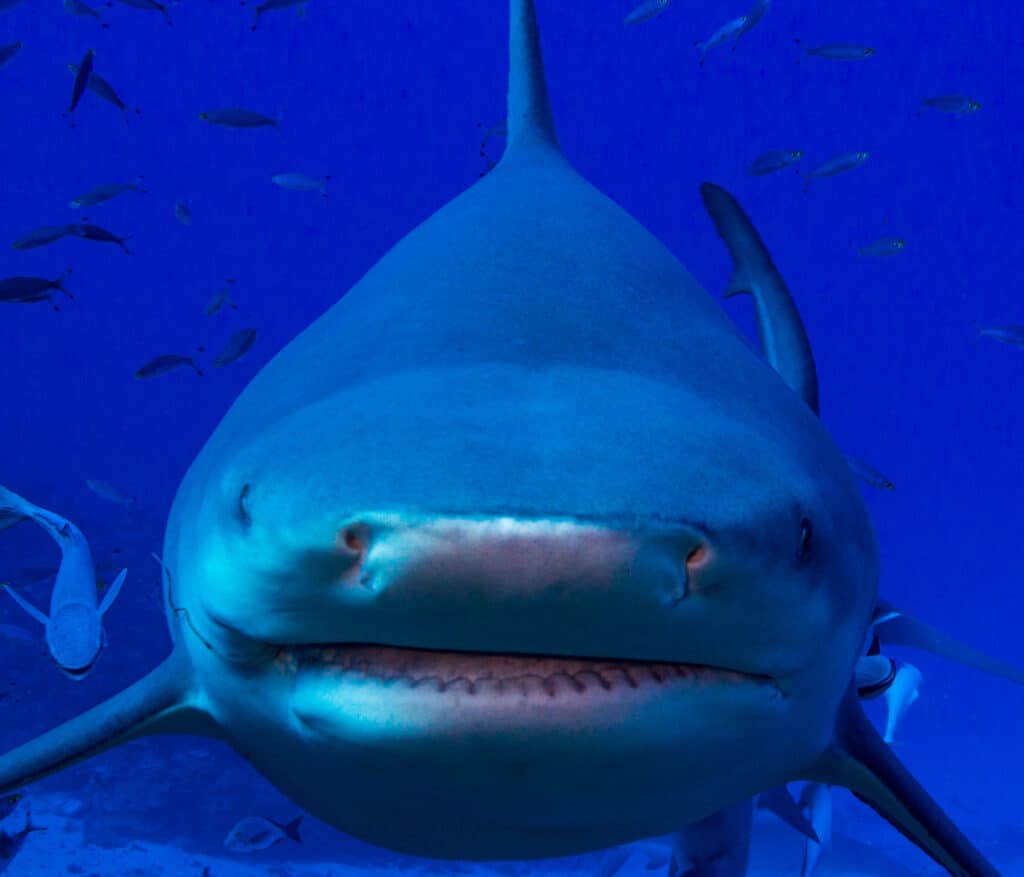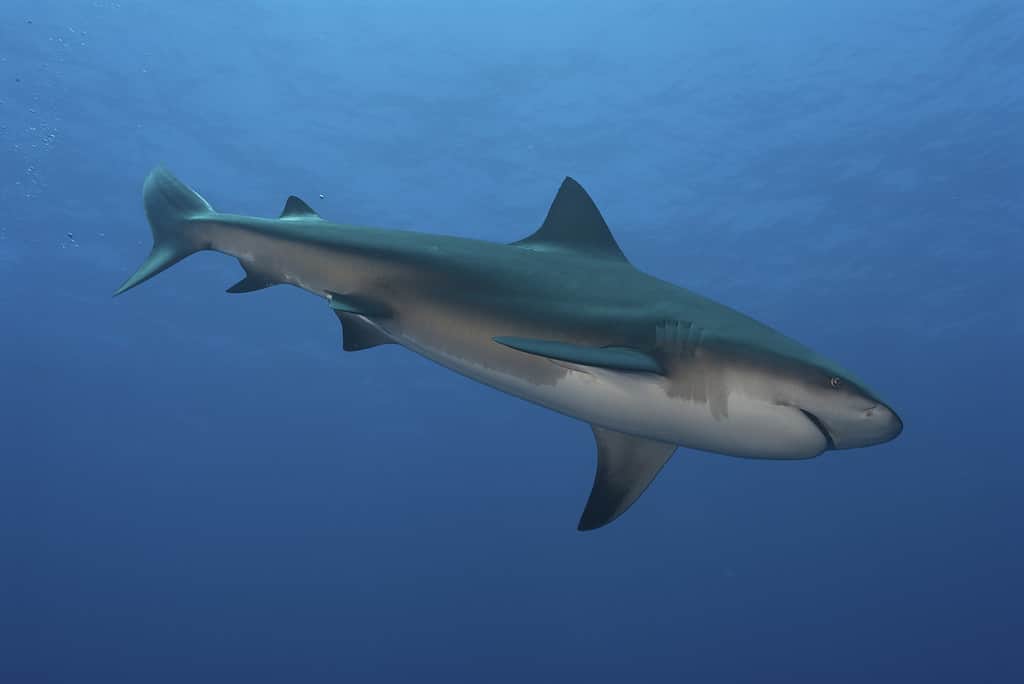Bull sharks and giant squids are fearsome predators swimmiing throughout the world’s oceans. While bull sharks typically prefer coastal waters, giant squids are found deep below the ocean’s surface. In addition, both predators use several feeding techniques unique to their species, some of which they could utilize in an epic battle. Discover who would win in a bull shark vs. giant squid battle and find out how each creature might defend itself.
Background on Bull Sharks
The bull shark is native to many oceans across the world, and its habitat includes shallow waters along the coast. While bull sharks primarily reside in saltwater sources, such as the Gulf of Mexico, they can survive in freshwater, too. Thus, bull sharks may swim up rivers by deltas or tributaries.
For instance, bull sharks have been spotted in Lake Nicaragua, located in Central America. Since bull sharks can navigate freshwater sources, they reside closer to human settlements than other shark species, resulting in a greater number of shark attacks on humans in these areas.

Bull sharks have been spotted in the Amazon River!
©iStock.com/Rhett Ayers Butler – Mongabay
Bull Shark Appearance
Bull sharks range between 11.8 and 13 feet in length. However, female bull sharks are usually larger than their male counterparts. Thus, while females may measure up to 13 feet long, males may barely exceed 11 or 12 feet. In addition, the weight of a bull shark lies between 210 and 290 pounds. Again, females weigh more than males on average. While the description of a bull shark may sound massive and terrifying, bull sharks are not nearly as large as other shark species. For example, the tiger shark grows up to 18 feet in length, and the great white shark may exceed a weight of 5,000 pounds.
In addition, the coloration of bull sharks appears light gray or dark gray with a white underbelly. Another feature of the bull shark is its sharp, serrated teeth. Bull shark teeth are extremely strong and fearsome, able to easily slice up the flesh of prey. However, bull shark teeth only measure around one inch in length. By comparison, great white shark teeth may measure greater than 6 inches long. Despite the smaller tooth size of the bull shark, the creature remains a formidable predator with a bite force of approximately 1,350 PSI.
How Does a Bull Shark Capture its Prey?
A bull shark detects and attacks prey through a method known as the “bump-and-bite.” Bull sharks lack good vision, meaning that spotting and attacking prey purely based on eyesight proves difficult for this species. Therefore, bull sharks will often detect their prey by bumping into them first, gaining an understanding of where the prey may reside. From there, bull sharks will attack swiftly by biting at prey and devouring it. In some cases, a bull shark may take a bite of prey, swim away, and circle back for another attack.
Various species comprise the diet of bull sharks, including dolphins, crustaceans, other sharks, and sea turtles. However, a bull shark’s prey differs depending on its location. Since this species can navigate up rivers, the bull shark may consume marine freshwater animals, too. For instance, freshwater prey of the bull shark may be sawfish, shrimp, or crabs. Furthermore, bull sharks have been reported to engage in cannibalism. At times, adults of this species may attack and eat juveniles.

Bull sharks use the bump-and-bite method to locate and attack prey.
©Michael Gomes/Shutterstock.com
Dangers of Bull Sharks
Bull sharks are one of the most dangerous shark species swimming in Earth’s oceans, and they can pose a threat to human life. Since bull sharks can navigate freshwater sources, like rivers and lakes, they are nearer to humans than other shark species. In fact, of the approximately 117 bull shark attacks on humans, 25 resulted in death.
In addition, bull sharks show intense aggression and violence toward their victims and prey. The species may attack a human without having felt threatened or provoked to do so. Luckily, bull sharks do not enjoy the taste of human flesh, though this fact has not halted them from committing assaults on humans in the past.
In addition, bull shark attacks are more dangerous to human life than attacks from other shark species. The bump-and-bite method utilized by the bull shark typically signifies a series of attacks on a human, as bull sharks may circle back to attack again and again for more. Therefore, some people consider bull sharks the most dangerous shark species on Earth. However, other species, like tiger sharks and great white sharks, remain extremely threatening, leaving the question of the most dangerous shark up for debate.
Threats to Bull Sharks
Both humans and predators threaten bull sharks, though the predators of bull sharks are few. For instance, only tiger sharks, sandbar sharks, and other bull sharks pose a danger to this species. Furthermore, most predators target juvenile bull sharks, as they are less adept at defending themselves compared to their adult counterparts. In addition, even fewer bull shark predators reside in freshwater sources. However, one report described a crocodile attack on a bull shark, meaning that crocodiles may be considered a predator of this shark species.
Some human threats to bull sharks include bycatch from fishing, habitat loss, and habitat fragmentation. Commercial fishing nets may entangle bull sharks among other marine animals. Entanglement may result in serious injury or death. In addition, habitat loss and habitat fragmentation occur when climate change and human disturbance in oceans cause the displacement of marine species. When bull sharks lose their homes to habitat loss, they must find other areas to feed and mate. If bull sharks cannot discover a habitable environment, they will suffer, and their population numbers may decline.

Entanglement in fishing nets remains a huge threat to bull shark populations.
©OlegRi/Shutterstock.com
Background on Giant Squids
Unlike bull sharks, giant squids prefer the ocean depths, as opposed to shallow coastal waters. At depths of almost 3,000 feet, the giant squid is accustomed to dark, desolate surroundings. In addition, the habitat of the giant squid includes tropical or subtropical waters. Giant squids are also categorized as cephalopods, meaning they are invertebrates that use gills to breathe.
However, many researchers have debated the true classification of the giant squid. While some contend that giant squids belong as a subspecies of another squid group, others believe that the giant squid remains a separate invertebrate species. One reason behind the classification confusion is that the giant squid harbors similar features as other squid species, like the colossal squid.
Giant Squid Appearance
Giant squids have an interesting appearance marked by tentacles, huge eyes, and many arms. For one, the giant squid has eight arms and two tentacles, which include suction cups that latch onto prey. Giant squid tentacles may measure double their body length. In addition, giant squid eyes are incredibly large, measuring around 10.6 inches in diameter. In fact, giant squid eyes are so big that they have often been compared to the size of a human head or a dinner plate. These eyes are also powerful and useful to the giant squid, as they allow it to see prey and predators from great distances.
Furthermore, the giant squid measures up to 43 feet in length. However, one report claimed to have spotted a giant squid measuring 59 feet long. While scientists are unsure of the giant squid’s true maximum length, they do believe that the species is growing. In fact, some researchers state that giant squids may evolve to exceed 66 feet in length, a measurement greater than the length of a bowling lane.
In addition, some believe that giant squids are the largest squid species in the world. However, the colossal squid rivals the giant squid in size, and the colossal squid has also been said to be the largest squid on Earth. While the colossal squid attains a greater length than the giant squid at 46 feet, the giant squid maintains a greater mass. Therefore, the largest squid species in the world has yet to be officially determined.

Check out these giant squids swimming next to one another and notice their massive eyes!
©Jiri Flogel/Shutterstock.com
How Does a Giant Squid Capture its Prey?
Giant squids use suction cups on their two tentacles to latch onto prey. These suction cups feature small teeth that can grab prey and pull it close to the giant squid. When the prey arrives at the giant squid’s mouth, it meets the beak, which is extremely sharp and large. From there, the beak aids the squid in consuming prey, as it cuts up food into smaller pieces.
After encountering the beak, the prey meets the radula. The radula is a body part of the giant squid much like a tongue, and the radula includes small, sharp teeth that help devour the prey. After the prey has been sliced up into bite-size pieces, the giant squid can swallow its victim to finalize the feeding process. In addition, examples of prey that comprise the diet of the giant squid include crustaceans, fish, and other cephalopods.
Dangers of Giant Squids
Giant squids can pose a danger to human life, though giant squid attacks on humans are rare. Since the giant squid resides at great depths underwater, it is unlikely to encounter humans. However, the giant squid is highly aggressive and may use several tactics to stun and capture a human victim. People most likely to encounter a giant squid or to experience a giant squid attack are divers. Overall, though, giant squid attacks are highly uncommon, meaning that they pose very little danger to human life.

Giant squids use their beaks to attack prey or to defend themselves from predators.
©The Trustees of the Natural History Museum, London / CC BY 4.0 – Original / License
Threats to Giant Squids
Like the bull shark, both humans and predatory threats exist for the giant squid. However, predators threaten the giant squid more than they do the bull shark. For instance, some predators of giant squids include some shark species and sperm whales. Luckily, though, giant squids utilize various tactics in avoiding predation. For one, the giant squid lives deep underwater, where little marine life resides and where darkness conceals the creature from predators. In addition, giant squids can blend into their surroundings through camouflage, which hides them from predators.
Furthermore, a squid that encounters a predator may release ink, which irritates the eyes, sense of smell, and sense of taste of the predator. Releasing ink will also decrease clarity in the surrounding water, barring the predator from locating the squid based on eyesight alone. When a squid releases ink into the water, it will have a chance to escape its predator.
However, if the predator catches up to the squid, the giant squid will take other protective measures. For example, giant squids may bite at a predator with their sharp beaks, or they will wrap their long tentacles around predators, trapping them.
Some human dangers that threaten giant squid populations include pollution and fishing. Several types of pollution exist, such as water contamination or noise pollution. Water contamination can cause illness or death in marine animals, and noise pollution may decrease the giant squid’s ability to hear underwater, stalling communication and feeding. Bycatch from fishing may injure giant squids or leave them unable to survive on their own. In addition, habitat loss and fragmentation may also harm the giant squid, much like these factors harm the bull shark.

Pollution like microplastics in the earth’s oceans can decrease water quality and harm marine animals.
©iStock.com/pcess609
Bull Shark vs. Giant Squid: A Comparison
| Characteristics | Bull Shark | Giant Squid |
|---|---|---|
| Size | 11.8 to 13 feet long | Up to 43 feet |
| Weight | 210 to 290 pounds | 330 to 606 pounds |
| Features | Light or dark gray with a white underbelly | Huge tentacles with suction cups and large eyes |
| Habitat | Shallow coastal waters or freshwater sources | Tropical or subtropical waters at great depths (2,950 feet) |
| Prey | Dolphins, sea turtles, crustaceans, stingrays, and other sharks | Crustaceans, fish, and other cephalopods |
| Predators | Tiger sharks, sandbar sharks, humans, and other bull sharks | Some shark species, humans, and sperm whales |
| Dangers | Violent, serrated teeth, powerful predator, bite force, and aggression | Tentacles with suction cups, radula, ink, aggression, and beak |
| Threats | Entanglement in fishing nets and habitat loss | Pollution, habitat loss, and fishing |
| Dangerous to Humans? | Yes (especially in freshwater or coastal waters) | Unlikely (attacks are rare due to the depth at which it resides) |
Which Animal Would Win in a Fight: Bull Shark or Giant Squid?
In an epic battle between a giant squid and a bull shark, the bull shark would emerge victorious. While the giant squid could defend itself from the bull shark by releasing ink, it wouldn’t be a powerful tactic. Bull sharks already have poor eyesight, meaning that ink would be a futile effort in clouding the vision of the bull shark. Through the bump-and-bite method, the bull shark would already know where the giant squid lies without using its eyesight. Thus, it would be too late for the giant squid to escape.
If the giant squid were to fight back, though, the bull shark maintains an advantage: strength. While one might assume the giant squid to be extremely strong, its physical strength cannot rival that of the bull shark. The giant squid could bite at the bull shark with its beak, but giant squid beaks do not record a powerful bite force. In fact, the bite force of a giant squid lies around 100 PSI. By comparison, the bite force of a bull shark measures 1,350 PSI. Therefore, the bull shark could overpower the squid in a fight, making it the winner of this epic brawl.

Able to withstand the giant squid’s defensive measures, the bull shark is crowned the victor of this battle.
©iStock.com/FionaAyerst
Thank you for reading! Have some feedback for us? Contact the AZ Animals editorial team.








